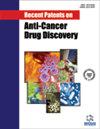Stem Cell Markers in Neoplasms and their Relationship with Progression-free and Overall Survival in Patients with Recurrence
IF 4.1
4区 医学
Q3 ONCOLOGY
Recent patents on anti-cancer drug discovery
Pub Date : 2024-05-10
DOI:10.2174/0115748928277672240429065526
引用次数: 0
Abstract
Background: Gliomas account for 30% of primary brain tumors in adults, and despite the scientific progress in the field, recurrence is prevalent. Glioma Stem Cells (GSCs) can generate tumor cells in vivo and in vitro and they are associated with treatment resistance, tumor progression, and recurrence. Furthermore, the expression of SOX transcription factors (SOX1, SOX2, SOX9) in these cells is responsible for maintaining an oncogenic genotype and is associated with an aggressive tumor phenotype. The relationship between SOX transcription factors and their prognostic role in recurrent gliomas has not been described in detail. Therefore, we set out to describe the relationship between SOX expression and Progression-free Survival (PFS) and Overall Survival (OS) in patients with recurrent gliomas. Methods: In this observational study, we have retrospectively analyzed 69 patients, of which 20 met the inclusion criteria. The clinical, radiological, and histopathological findings have been described, and survival analysis has been performed according to SOX expression for PFS and OS. Results: We found SOX1, SOX2, and SOX9 to show a non-statistically significant trend with increasing histopathological grade, co-expressed with Ki67, a cell proliferation factor. Conclusion: There has been found an inversely proportional correlation between the degree of immunopositivity of SOX1 and OS. A higher SOX1 immunopositivity could predict a worse clinical prognosis. There has also been found an interaction between a pluripotent genotype (GSC) and cell proliferation.肿瘤中的干细胞标记物及其与复发患者无进展生存期和总生存期的关系
背景:胶质瘤占成人原发性脑肿瘤的 30%,尽管该领域的科学研究取得了进展,但复发现象仍很普遍。胶质瘤干细胞(GSCs)可在体内和体外生成肿瘤细胞,它们与治疗耐药性、肿瘤进展和复发有关。此外,这些细胞中 SOX 转录因子(SOX1、SOX2、SOX9)的表达负责维持致癌基因型,并与侵袭性肿瘤表型相关。SOX转录因子之间的关系及其在复发性胶质瘤中的预后作用尚未得到详细描述。因此,我们试图描述复发性胶质瘤患者中 SOX 表达与无进展生存期(PFS)和总生存期(OS)之间的关系。研究方法在这项观察性研究中,我们回顾性分析了 69 例患者,其中 20 例符合纳入标准。对临床、放射学和组织病理学结果进行了描述,并根据SOX表达对PFS和OS进行了生存分析。结果:我们发现,SOX1、SOX2和SOX9与细胞增殖因子Ki67共同表达,随着组织病理学分级的增加,SOX1、SOX2和SOX9的表达呈非统计学显著趋势。结论研究发现,SOX1的免疫阳性程度与OS之间存在反比关系。SOX1免疫阳性率越高,预示临床预后越差。此外,还发现多能基因型(GSC)与细胞增殖之间存在相互作用。
本文章由计算机程序翻译,如有差异,请以英文原文为准。
求助全文
约1分钟内获得全文
求助全文
来源期刊
CiteScore
4.50
自引率
7.10%
发文量
55
审稿时长
3 months
期刊介绍:
Aims & Scope
Recent Patents on Anti-Cancer Drug Discovery publishes review and research articles that reflect or deal with studies in relation to a patent, application of reported patents in a study, discussion of comparison of results regarding application of a given patent, etc., and also guest edited thematic issues on recent patents in the field of anti-cancer drug discovery e.g. on novel bioactive compounds, analogs, targets & predictive biomarkers & drug efficacy biomarkers. The journal also publishes book reviews of eBooks and books on anti-cancer drug discovery. A selection of important and recent patents on anti-cancer drug discovery is also included in the journal. The journal is essential reading for all researchers involved in anti-cancer drug design and discovery. The journal also covers recent research (where patents have been registered) in fast emerging therapeutic areas/targets & therapeutic agents related to anti-cancer drug discovery.

 求助内容:
求助内容: 应助结果提醒方式:
应助结果提醒方式:


